Puppetry Resources and Examples
On this page you find a few ressources on hand-puppet building. They connect to the work I do on Character Design at Malmö University and to the character design work and puppet building I do on commission and for my own projects.
My puppet building is part of research into character design, representation, etc (if you like fancy words: it's the reflective practicioner's artistic research). Some puppets have been put to use in the role-playing game Schlaraffia, but are not related to that specific game - it is rather more open for all kinds of appropriations.
2022 to 2024, I learned more on puppet building at Bernd Ogrodnik's Worlds Of Puppets Academy of the Wooden Puppet. The Academy is seriously good, the courses are fun and it helps me to do build better puppets systematically. It adds nicely to my own professional knowledge and abilities... Remember: Doing puppetry is doing theatre when performed live but it is doing film when it is produced for being filmed, obviously (otherwise filmed live-puppetry is a filmed theatre performance, of course). Accordingly, much theory and routines, also traditions relating to these media can be used and blended in working with puppetry.
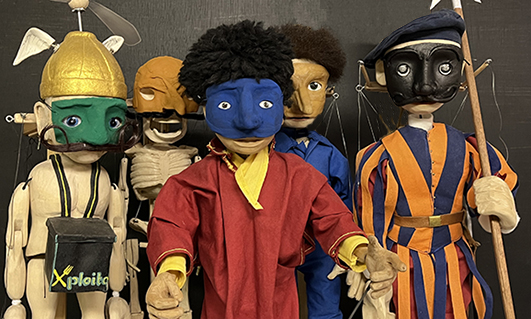

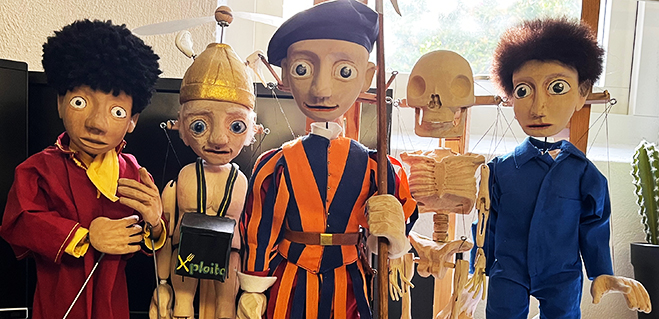
Like dioramas and models are ideal for planning set designs, puppets for stop-motion film are ideal for setting up situations that are to be drawn for a comic, they help with planning and showing proportions and perspectives on the action (and inaction) well.
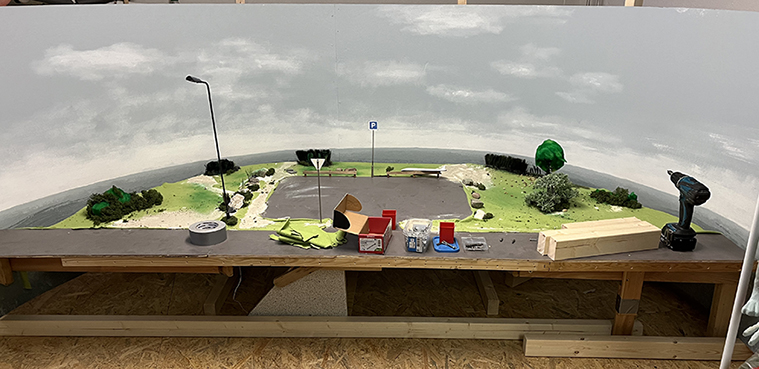
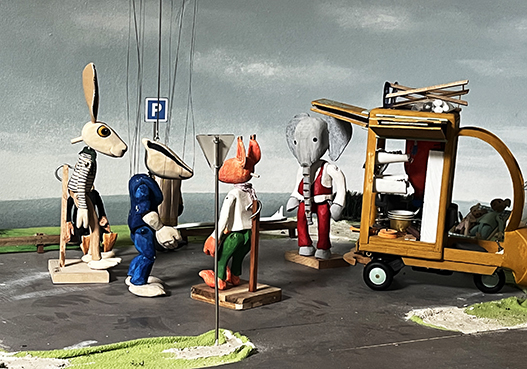
Here are a few simple table-top puppets that I did on their warm up-course to understand some principles better. They are partly turned into and partly doubled up by marionettes for a puppet-film project shown in the images above:
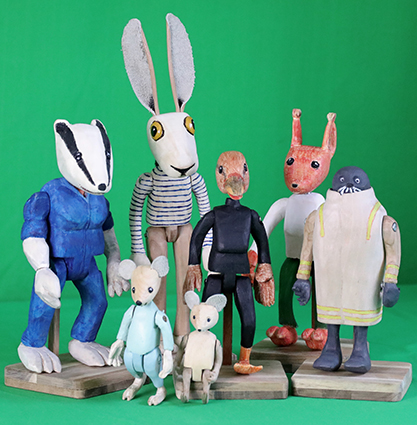
Quite some techniques and puppets have been built since. The different controls become even more diversified and the same figure gains different ways of moving if attached to or build for different controls - and with different movements they gain a different personality. These aspects need to be tested in practice, they need to be done and experienced. I spare myself and you, dear reader, some nerdic reflection on different puppet controls here, but you can book me for a presentation and workshop on the matter, if you want to dive in...
Simple Hand-Puppet-Construction
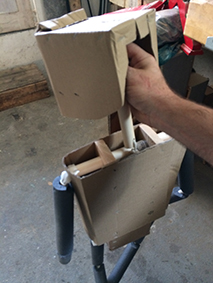
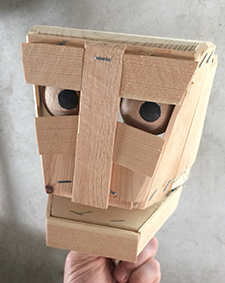
Building instructions for simple hand-puppets with a simple box-head-design draws on the puppet-style featured by Malmö Dockteater (Malmö Puppet Theatre) and Malmö Stadsteater (Malmö City Theatre) for download as a pdf-file here. The puppet is simple in its construction and cheap to built, not at least as it can be built from waste-material. It features no strings nor rods but is rather controlled by a puppeteer placed directly behind the puppet in simplified Bunraku-style.Access to the controls for the head is straight through the back of the head. Here is a link to the step-by-step description on instructables.
Here is a link to the innstruction sketches for the box head (pdf-file), and here is a link to the drawing that shows the construction-principles of the body (pdf-file)
Laser-Cut Controls for Hand-Puppet Heads: The Nordberg Controls
To control the movement of the eyes and mouth of a hand puppet, some basic mechanism is needed inside the puppet’s head, obviously. While an abundance of individual control mechanisms exist, they all demand quite some development, adjustment, and care. Also, most are build as specific solutions for individual puppets. In difference to that, the control mechanism you can download here as pdf-file consists of a laser-cut standardised kit developed by Mattias Nordberg for puppet building on our Character Design-course at Malmö University. You are invited to use it, the source-file (in ai-format) for the laser cutter is provided for download here. Please note that it is published under CC SA BY NC - i.e. you may do professional puppets etc, but not sell the controls-kit for profit. Here is a link to the step-by-step description on instructables.
Continuing from the above controls, we (Mattias Nordberg, Oskar Lennmarken, and me) have developed controls for smaller cardboard eggs and other hollow hand-puppet head-designs. Again, the components are laser-cut from fibre-board (mdf board), the smaller version allows of course to build smaller puppets that need less material, are easier to store and transport, are lighter for puppeteers to control and hold for longer. Also, adaptation into diverse other shapes than humanoid puppets seems easier, we keep testing this, too.
The laser-cutter file is provided for download here (in ai-format). As with the previous design, you are invited to use it, but note that it is published under CC SA BY NC - i.e. you may do professional puppets etc, but not sell the controls-kit for profit. Here is a link to the step-by-step descriptions for the assembly of the controls and insertion or integration into a puppet head on instructables.
Some Puppets
Stories are crucial for characters: you cannot have objects or figures that go beyond typical or even stereotypical patterns, if they have no developed background / backstory / specific - characteristics. The knight and the green man below, for example, are rather typical, but if you imagine them to have been the tree and one of the figures from Beckett's Waiting for Godot, they change considerably. The knight is a Sicilian rod-marionette built from empty tin cans, while the green man is a string-marionette built from twigs and bits of fire-wood.
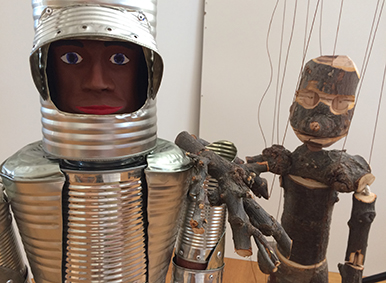
All kinds of narrative contexts ask for figures that are detailed enough so that they are believable and convincing in their specific context. Very different routines exist on how to develop figures far enough, so that they work well or even get a live of their own (kind of). In acting, some people imagine and develop background stories for the characters they play, so that they can fill them with individual mottivation and individuality (method acting goes much further, obviously - how one does method acting on theatre stages while switching between different plays on alternating days, I have no clue). Anyway: figures benefit from backstories and differentiated ways of behaviour etc. Striking examples are avatars in games that only make sense to be played because of the narrative diversion and personal investment of thoughts on individual abilities, inabilities, ticks, and traits.
Characters express their traits or personality, specific moods in body language, facial expressions, in clothing and accessories (tools, guns, baggage, etc.). Of course, body language is one of the crucial tools in puppetry, so always keep in mind that the puppet in play is using some of the mentioned areas, which get not obvious in pictures!
The following example of a glove-puppet is a neutral head, which can be individualised by adding different noses, eyes, or hair. These are held in place with double-faced tape or safety pins. When a specific figure is fully developed, the features could be glued to secure them in place, but the head would lose its adaptability, of course.


















All rather typical features, those in the above. The strength of these figures is their typicality, you can use them for great conversations, when you want to reduce complexity of explanations, for example. And: of course you can add individuality in the way you play them based on some backstory...
The following hand-puppet on the left is supposed to look like a Greylag goose (Anser anser) in natural size. I am quite fond of some of the bird-puppets that are for sale, but my hands are too large to play them well, so I had to sew my own. Mine originally had a opening in the belly, but is difficult to play through that one, so I opened it up at the breast. This restricts the usability of the puppet, it now needs to be played as if sitting or nesting, but the neck and beak are controlled better this way. The puppet on the right is a badger, made from a painted Brämhults juice-bottle. It is a simple design, too: the bottom cut out, a piece of wood screwed in as a handle to the head and the body hotglued onto the bottle's sides (image in center).
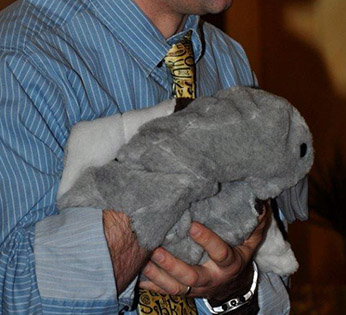
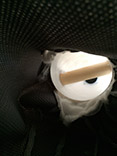
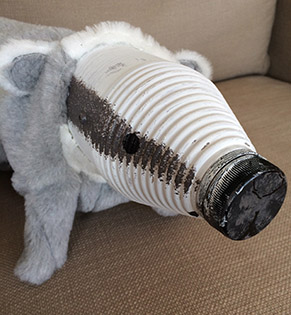
The kind of puppet below is called a marotte. It is cut from poplar wood that is so scaringly white that it has influenced this figures' character quite a lot. Even dousing the wood in black tea did not change that. The form is a variation on Mr. Punch and on the Kaspar figure of the Hohensteiner tradition (the old form, not that modernised stuff, bah humbug...). I made it to be used as the courtjester's sceptre at Schlaraffia Malmöhus.



Puppets can talk much more freely than we can: A lot of subjects can be introduced and discussed in a completely different way by putting an intermediary between the audience, focus group, etc. and the interviewer, teacher, campaigner etc. It also is much easier to ventilate thoughts by making a puppet say them, the puppeteer can pretend to just happen to stand behind it...
Adult people tend to get irritated by being addressed by puppets at first, but most are able and willing to enter the playful special situation that is a conversation and interaction with a puppet. Children tend to be very interested in them, anyway. Here the lack of distance can even turn out to be a problem - but an abundance of strategies deals with this, of course.
The following glove-puppet (and a rather longish glove it is) giraffe came into existence as a by-product of discussing approaches to museum didactics with Malmö museer: they do have a real giraffe - albeit stuffed - in their foyer. And there were other giraffes in Malmö (of steel, but more about that you have to find out yourself). This one is made from potato-sacks, the eyes are cuttings of a styrofoam ball.
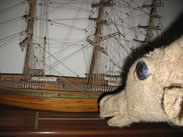
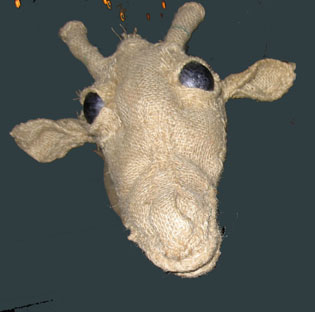
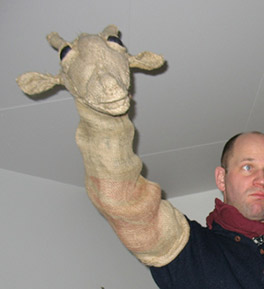
Wiking Kings ?!
Other examples for puppets are the following, all based on the theme "Wiking Kings" and starting from the names of the individual kings - some developed rather far from the original setting one would assume. A series of rod puppets turned out rather large and became a blend of rod and glove-puppets - each to be played with two hands (or three, coming to that). As a bunch of wiking kings are slightly limiting the thematical options, some got figure and gender diversified. Harold Bluetoeth turned into an Elvis-impersonator (left) and Gorm the Older doubles as grandmother, and is good at it (right). Much better play now!
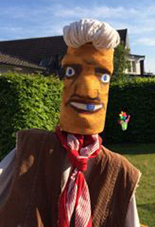
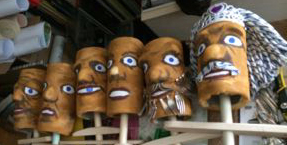
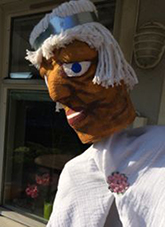
In the centering image the second from the right is an earlier version of the figure that turned into the blue glove-puppet seen below. The forks rattled more nicely against the pipe wrapped in plastic cast-bandages, but it was not working well.
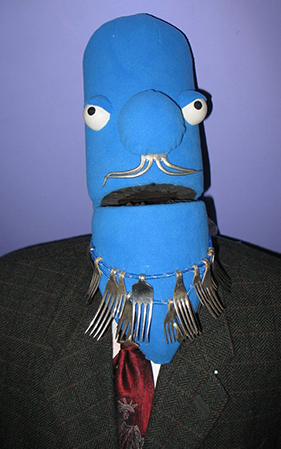
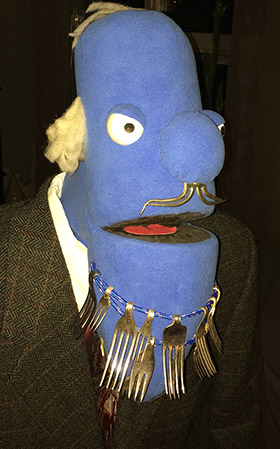
This blue faced gentleman came into existence starting from the name "Sveyn / Svend Forkbeard" and turned into a relative of the muppets. This one stands taller than me. Quite imposing, especially, as it sports such a friendly face (wikings are not known for their friendliness, I was told...). Central is the mouth that works as the hinge between upper and lower head. The rest is constructed around it. The head is hotglued from a yoga-mat (cheap semi-hard foam) and covered with synthetic-fleece, which was sewed together, pulled over the cones of upper and lower head and glued onto the rim of the mouth. Nose (fleece-covered foam) and eyes (from a ping-pong-ball) were hot-glued into place. The hair is fixed to the head using a fleecing needle. The hands from blue fleece are gaffer-taped into the cuffs of the jacket, the arms are opened at the seams half-way up the lower arm where the puppeteer get in the hands. The head is played by getting your other hand through an opening in the back of the jacket and shirt up the neck of the figure and into the head itself. To be able to perform longer plays (or whatever) the chest can be settled on a support-broomstick.